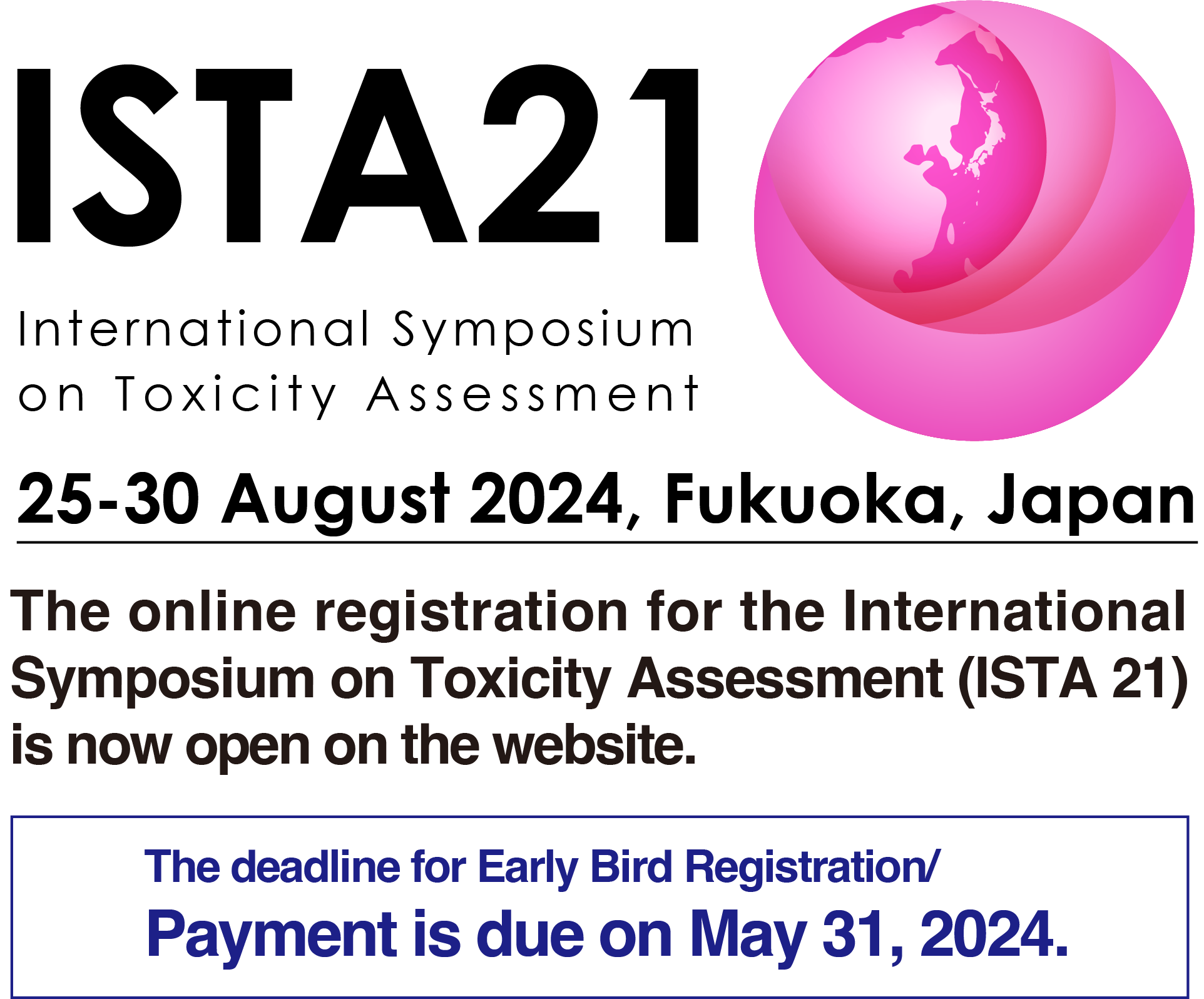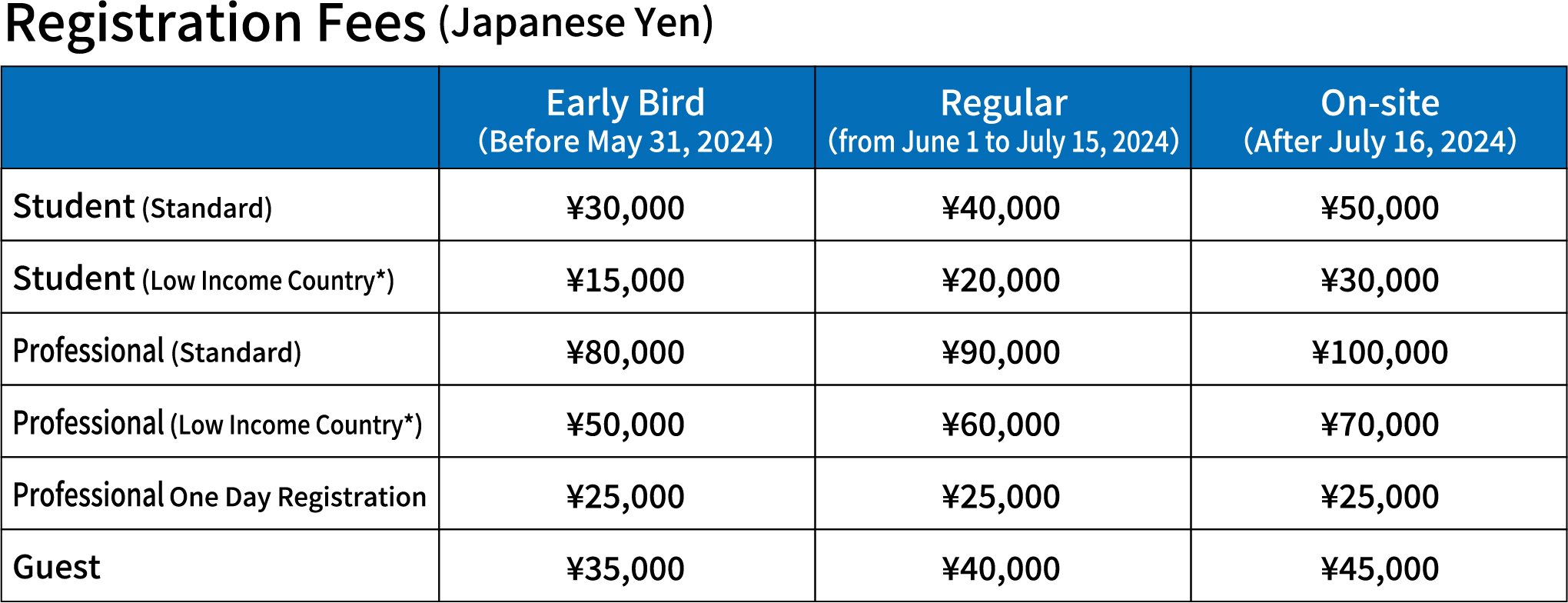Registration Instructions
Complete the registration form by clicking on the appropriate button below.
Abstracts
The 21st International Symposium on Toxicity Assessment (ISTA21)
invites your abstracts for oral and poster presentation.
Abstract submission system is now being prepared and will be open soon.
Before abstract submission, you have to register for the meeting and pay a registration fee in advance.
SCIENTIFIC SESSIONS
The scientific topics for ISTA 21 are listed below:
1. Accumulation of and effects by heavy metals or radioisotopes in aquatic organisms
Aquatic organisms have been exposed to environmental pollutants, such as heavy metals or radioisotopes, involved by various human activities. Thus, elucidation of the biological effects by these pollutants is not only scientifically but also socially significant. This session covers a wide range of topics related to heavy metals and radioisotopes in the aquatic biosphere.
2. Analytical methods and dynamic analysis of environmental chemicals
This session handles research presentations, represented by the keywords, “analytical methods” and “dynamic analysis”. Because the actual environmental concentrations of harmful chemical substances, involved by human activities, have recently attracted social attention, the new or highly sensitive analytical methods are needed, for example, to reveal the concentrations in air/water, and to analyze their dynamics in the environment. In this session, we will gather new information related to the session topics and discuss to advance future research.
3. Bioassays and testing methods
Ecotoxicological effects of chemicals and their mixtures are usually examined by internationally standardized methods using various testing organisms. While the number of chemicals is steadily growing and their functions become diversified, various testing methods with various endpoints have recently developed and proposed to international organizations such as OECD and ISO. This session covers these bioassays and testing methods, validated for reference chemicals and applied to various emerging contaminants to evaluate the impacts on human and wild animals.
4. Biology of Invertebrates - Toward the establishment of excellent eco-monitoring systems
Invertebrates such as marine snails and insects has been used for decades, as the sensitive biosensor that evaluate the environmental pollution. However, understandings of the basic mechanism underlying the essential activities of the animals, such as reproduction, are still insufficient. In this session, fundamental research from diverse aspects, including physiology, biochemistry and molecular biology on invertebrates are welcome.
5. Ecological effects by global warming/climate change
Global warming and climate change affect terrestrial and aquatic ecosystem in a variety of ways. In the session, the papers are encouraged to discuss the latest understanding of the global warming and climate change issues on individual, population, and ecosystem levels. The session provides an opportunity for researches to share works on the related topics and build interdisciplinary collaborations.
6. Ecological effects of and remediation from eutrophication and hypoxia at individual, population and community levels
Hypoxia caused by anthropogenic eutrophication is a major environmental issue affecting various coastal ecosystems and is increasingly becoming a global concern. This session aims to present the ecological impacts of coastal eutrophication and hypoxia, alongside other factors like water temperature and hydrogen sulfide, on marine organisms at individual, population, and community levels. Furthermore, studies concerning the remediation of degraded coastal ecosystems are also encouraged.
7. Ecological impact of chemicals produced by harmful algal bloom
Harmful algal bloom (HAB) species produces a variety of chemical substances such as shellfish poisoning causative substances, chemicals that cause mass mortality of fish and shellfish, and allelochemicals that are involved in inhibiting the growth of other phytoplankton species. These known/unknown chemicals have often negative effects on aquatic ecosystems and humans. This session provides the latest topic about the biological effects and mechanisms of chemicals produced by HABs. The distribution expansion mechanism, monitoring methods and countermeasures of HABs are also encouraged.
8. Effect of micro and nano plastics on aquatic animals at experimental and real condition
Plastics have permeated our daily lives due to their affordability, lightweight nature, and durability. However, their widespread production and slow degradation have resulted in a global plastic pollution problem in aquatic ecosystems. This threat has evolved from large plastic debris to minute particles, including microplastics (MP, less than 5 mm) and smaller nanoplastics (less than 1 µm). It is crucial to understand the environmental behavior, potential impacts on aquatic animals, and their role as vectors for other pollutants. This session will explore the testing methods, observed effects, and risk assessment associated with microplastics and nanoplastics to shed light on this critical environmental issue.
9. Endocrine disruption, other reproductive failure and issues on the Fukushima nuclear accident
Endocrine disruption in wildlife is still one of matters of public concern. A certain reproductive abnormality, called as consecutive sexual maturation, has been observed in a rock shell population in the vicinity of the Fukushima Daiichi Nuclear Power Plant. In this session, we will focus on endocrine disruption and other reproductive failure observed in the environmental pollution and its related issues, to investigate its causal factor(s) and mode of action(s). Issues on the Fukushima nuclear accident, including radioecology and environmental radioactivity, are also welcome for further discussion.
10. Environment and Mineral Deposition
Various animals, plants and microorganisms accumulate and use the inorganic elements and metals inside or outside the cells for the protection, mineral storage, and gravity sensing, etc. The biological mineral deposition (biomineralization) is regulated by organic molecules to produce the fine microstructures and high functional features of minerals and metals. The biological mineral deposition contributes to the global biogeochemical cycles of metals, minerals, carbon, and phosphorus. The ratio of isotopes and trace elements in biological mineral deposition indicated the environmental information such as temperature, oxygen level and pollution, etc. The formation mechanism of biological mineral deposition will give new insights for the environmental science.
11. Environmental risk of antifouling biocides etc.
Antifouling (A/F) biocides are typical chemicals intentionally used in water bodies. Organotin biocides were banned in 2008 and cybutryne has been banned in 2023 due to their significant environmental risk. It was recently reported that paint particles containing A/F biocides etc. were floating on the ocean surface, and this occurs concerns that they may contaminate the ocean as microplastics containing harmful components. This session will focus on the environmental risk of paints/plastics additives such as A/F biocides, plasticizers, UV filters etc. persisting in aquatic environment.
12. Environmental Toxicology of terrestrial animals/ecosystems
All living organisms are exposed to a wide variety of chemicals, but data on the toxicological effects of environmental chemicals on terrestrial organisms are scarce, and the reality and effects of these chemicals are still unclear. This session will address the effects of various environmental chemicals on terrestrial organisms. No restrictions will be placed on the subject of environmental chemicals. This session will also include laboratory studies on the effects of environmental chemicals on terrestrial organisms, as well as epidemiological studies in wildlife and computer simulations.
13. Exposure to Environmental Chemicals and Children's Health
Due to the increase in the number of chemicals used in our daily life, their potential adverse effects on human health, especially on children's health, have been growing concern. Children are in the process of growth and development and are vulnerable to maternal and early childhood exposures. This session will discuss recent advances in research on chemical exposure assessment and impact of chemical exposure on children's health. The following topics will be covered, but not limited to, in this session: 1. Birth cohort or epidemiological study assessing the effects of chemical exposure on children's health; 2. Human biomonitoring of chemical exposure; 3. Method development for large-scale biomonitoring or epidemiological study; 4. Pharmacokinetic or toxicokinetic of environmental chemicals in human body.
14. Hematotoxicity and immunotoxicity
The "Hematotoxicity and Immunotoxicity" session aims to explore the adverse effects of chemicals on hematopoietic cells and immune function. The circulatory system plays a central role in maintaining life activities by transporting oxygen, nutrients, and endogenous substances. However, exposure to chemicals causes dysfunction of blood cells and hematopoietic tissues, resulting in various physiological disorders. In addition, emerging concerns about the uptake of chemicals and particulate matter into the body raise questions about their potential immunomodulatory effects. This session will provide a platform to present their latest findings, exchange ideas, and engage in discussions regarding the mechanisms, assessment methods, and implications of hematotoxic and immunotoxic responses.
15. Impact at individual, population and community levels by environmental pollutants, and its risk communication with citizens
We will discuss how to explain the risk assessment of classic environmental pollutants (Dioxins/furans, PCBs, DDTs, PAHs, Heavy metals etc.), emerging contaminants (PFCs, PPCPs etc.), and endocrine disruptors, as well as efforts regarding risk communication.
16. Neurotoxic chemicals and their effects on humans and wildlife
As demonstrated by the Minamata disease and Morinaga arsenic milk poisoning cases in the 1950s, the exposure to metals and other pollutants in the environment affects the developing brain and exerts adverse effects throughout life. This session aims to deepen our understanding of the chemicals and their neurotoxic effects on humans and wildlife, and to share information on research methods and animal models for the early detection of such effects in a precise manner.
17. New Approach Methodologies (NAMs) in Toxicology and Environmental Toxicology
This exciting session will explore the cutting-edge of toxicology and environmental toxicology with New Approach Methodologies (NAMs). NAMs offer the potential to reduce or replace animal testing while enhancing health assessments of humans and wildlife. Experts will discuss the latest developments in NAMs, including in vitro, in silico, and high-throughput screening technologies that are setting new standards for hazard and risk assessments. This session is ideal for toxicologists, regulators, and anyone interested in the future of chemical safety assessment.
18. Recent research effort on legacy and alternative per- and polyfluoroalkyl substances
Per and polyfluoroalkyl compounds (PFAS) include many homologues with different physical properties, and some of homologues are persist in the environment and accumulate in living organisms. In addition to those conventionally produced, new homologues are being developed one after another as alternatives. It has been concerned that the release of PFAS into the environment on a global scale and their potential effects on human and wildlife. This session will cover recent research topics on PFAS, including analytical techniques, environmental fate, and biological effects.
19. Signals from aquatic organisms, the behavioral effects as a toxicity assessment indicator
In recent years, the behavioral alteration of aquatic organism has been gathering much attention as an indicator of pollutant toxicity assessment. Participants will share results and discussions of their research activities on behavioral impairments in aquatic organisms, which represents the abnormality of overall fitness of individuals. In addition, this session will cover a study on biological early warning systems (BEWS) using analysis of behaviors of aquatic organisms for detecting water pollution due to a variety of toxic chemicals. Effective on-site application of various methods using behavioral analysis in aquatic organisms will be introduced and discussed.
20. Toxicity assessment and its environmental/ecological relevance
Regarding the background and reasons why this Special Session was planned at ISTA21 and subjects to be discussed here, please refer to the website of ISTA21.




